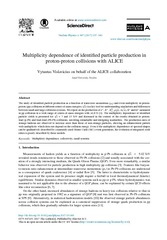Multiplicity dependence of identified particle production in proton-proton collisions with ALICE
Acharya, Shreyasi; Adam, Jaroslav; Adamová, Dagmar; Adolfsson, Jonatan; Aggarwal, Madan M.; Aglieri Rinella, G; Agnello, Michelangelo; Agrawal, Nikita; Ahammed, Zubayer; Ahmad, N; Ahn, SU; Alme, Johan; Altenkaemper, Lucas; Arsene, Ionut Christian; Bätzing, Paul Christoph; Djuvsland, Øystein; Dordic, Olja; Helstrup, Håvard; Hetland, Kristin Fanebust; Kileng, Bjarte; Langøy, Rune; Lardeux, Antoine Xavier; Lien, Jørgen André; Lindal, Svein; Lønne, Per-Ivar; Mahmood, Sohail Musa; Milosevic, Jovan; Nesbø, Simon Voigt; Nystrand, Joakim; Rehman, Attiq Ur; Richter, Matthias Rudolph; Røed, Ketil; Røhrich, Dieter; Skaali, Toralf Bernhard; Tambave, Ganesh Jagannath; Tveter, Trine Spedstad; Ullaland, Kjetil; Velure, Arild; Wagner, Boris; Wikne, Jon Christopher; Zhang, Hui; Zhao, Chengxin; Zhou, Zhuo; Zhu, Hongsheng; Aiola, Salvatore; Akindinov, Alexander; Alam, Sk Noor; Alba, José Luis Bazo; Aleksandrov, Dimitry; Allesandro, B.; De Albuquerque, Danilo Silva; ALICE, Collaboration
Peer reviewed, Journal article
Published version

Åpne
Permanent lenke
https://hdl.handle.net/1956/17950Utgivelsesdato
2017-11Metadata
Vis full innførselSamlinger
Originalversjon
https://doi.org/10.1016/j.nuclphysa.2017.05.088Sammendrag
The study of identified particle production as a function of transverse momentum \(p_{\text{T}}\) and event multiplicity in proton-proton (pp) collisions at different center-of-mass energies \(\sqrt{s}\) is a key tool for understanding similarities and differences between small and large collisions systems. We report on the production of \(\pi^{\pm}\). \(K^{\pm}\). \(K^{0}_{S}\). \(p (\bar{p})\). \(\Lambda (\bar{\Lambda})\). \(\Xi^{\pm}\) and \(\Omega^{\pm}\) measured in pp collisions in a wide range of center-of-mass energies with ALICE. The multiplicity dependence of identified particle yields is presented for \(\sqrt{s} = \textrm{7}\) and \(13\) TeV and discussed in the context of the results obtained in proton-lead (p-Pb) and lead-lead (Pb-Pb) collisions, unveiling remarkable and intriguing similarities. The production rates of strange hadrons are observed to increase more than those of non-strange particles, showing an enhancement pattern with multiplicity which does not depend on the collision energy. Even if the multiplicity dependence of spectral shapes can be qualitatively described by commonly-used Monte Carlo (MC) event generators, the evolution of integrated yield ratios is poorly described by these models.
